Obtaining simultaneous multiple dissolution profiles of solid oral dosage formulations
Pharmaceutical Technology Europe
Testing the dissolution rates of a pharmaceutical formulation (also known as in vitro availability) aids drug quality control and is a compulsory requirement of the British, European and US pharmacopoeias.
Testing the dissolution rates of a pharmaceutical formulation (also known as in vitro availability) aids drug quality control and is a compulsory requirement of the British, European and US pharmacopoeias.1–3 Dissolution testing provides comprehensive information about the dynamics of dissolution processes and is one of the first steps to facilitating the development of a new dosage form. It is also useful for assessing manufacturing reproducibility and can even be used to check the dissolution profile of generic formulations. The results of the test depend on both the chemical contents and the physical properties of the dosage, including particle size and binder composition.4,5

(PHOTOALTO/ALIX MINDE/GETTY IMAGES)
The recommended dissolution method in relevant pharmacopoeias results in an overall dissolution profile, where the absorbance is the sum of all soluble compounds present in a formulation. However, efforts are being made to obtain 'individual' profiles — i.e., profiles of all component parts of a formulation — with some strategies having already been developed.6–11 Individual profiles enhance the information that we have for a formulation and, as such, it is just as important to obtain an individual profile as it is to obtain a global profile, in vitro bioavailability or manufacturing controls.
Because of regulatory requirements, the pharmaceutical industry must perform a large number of dissolution profiles every day, which often requires many replicas of the same formulation. This article describes how automating the simultaneous recording of several replicas of the same formulation can facilitate dissolution testing. Additionally, we will examine the simultaneous recording replicas of global and individual dissolution profiles for active principles present in a pharmaceutical formulation.
Materials and methods
Reagents
All reagents used were analytically pure unless stated otherwise. Solutions were prepared in purified water by reverse osmosis and then deionised (18 M Ohm cm) using a Sybron/Barnstead Nanopure II water purification system equipped with a fiber filter of 0.2 µm pore size.
The assayed formulations and pharmaceuticals were:
- Septrin (80 mg trimethoprim/400 mg sulfamethoxazol; Celltech)
- 20 mg enalapril/12.5 mg hydrochlorothiazide (Ratiopharm España SA, Spain)
- 50 mg captopril/25 mg hydrochlorothiazide (Ratiopharm España SA, Spain)
- 857 mg amoxicillin/125 mg clavulanic acid (TEVA genéricos española SL, Spain).
Other reagents used were acids and alkalis to adjust the pH of the solutions — mainly hydrochloric acid and sodium hydroxide (both from Scharlau Chemie SA, Spain).
Assembly
The pH of the solutions was potentiometrically measured using a pH meter Crison GLP (Crison Instruments, SA, Spain), equipped with a double electrode glass/calomel. Ultraviolet visible spectra and solution profiles were recorded using a diode array spectrophotometer (Model HP5453; Hewlett Packard) with a flow-cell Hellma 6Q (Hellma GmbH & co Mülheim, Germany) of 1 cm light path using UV visible chemstation software (Agilent Technologies). Data were handled with the aid of Microsoft Office Excel, 2003.
The flow assembly used to obtain dissolution profiles comprised a mechanical stirrer (Heidolph RZR 2021; Heidolph, Germany) at 50 rpm and a homemade glass dissolution vessel, with size and shape according to instructions from pharmacopoeias. This vessel was immersed in a water bath (Model Tectron 200; J.P. Selecta, SA, Spain) at 37 °C. The continuous flow was generated by a peristaltic pump Minipuls 2 (Gilson). The pump tubing was made of Tygon R3607 (Ismatec) with an internal diameter of 2.06 mm. An online nylon filter (0.4 mm pore size) was placed at the tip of the tubing to retain insoluble matter from the solution vessel. All other tubing (Omnifit) was made of PTFE with an internal diameter of 0.8 mm (Figure 1).
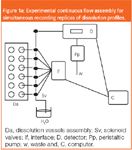
Figure 1a
The running of the flow assembly was assayed and optimised to obtain a suitable flow rate, as well as the length of the sample segments (period ON of the corresponding solenoid valve) and the period in which each valve should be OFF, which allows a segment from another vessel to be delivered, was also optimised. The goal of the optimisation was mainly to observe suitable absorbance values while avoiding the detector saturation. Optimisation was performed with the aid of the multiparametric procedure, which is known as MSM and has been discussed elsewhere.12–14 The optimised valves programme is depicted in Figure 1. The total flow rate was 4.5 mL/min.

Figure 1b
Apparatus
As shown in Figure 1, in order to develop dissolution tests the set of hydrochloride acidic solutions placed into the corresponding standard vessels were immersed into a commercially available water bath; the solutions were connected on-line with a muticommutation manifold, which enables profiles from different tablets (up to six) of the same formulation to be performed. This approach may help to solve the problems associated with large numbers of dissolution assays.
Testing was performed with the aid of a diode array ultraviolet–visible spectrophotometer (Model HP5453; Hewlett Packard) (as opposed to the simple spectrophotometer that is usually used in commercially available assemblies), which enables simultaneous recording of the absorbance of the solution at several wavelength values. This procedure is based on the derivative spectrophotometry for deconvolution of overlapped spectra and the zero crossing on the spectrum derivative.15–23
Procedures
Batch sample treatment
Tablets were taken and powdered, and the required amount was separated, weighed, dissolved and filtered to avoid insoluble excipients, and then filled to mark with the required medium.
Preliminary batch experiments established the procedure for simultaneous profiles of both active pharmaceuticals present in the formulation; optimum pH or solvents required. Spectra were recorded from different solutions tested at different pH values, and first and second spectral derivatives were also obtained. Derivative spectra from the two active principles present in the formulation were compared to select wavelengths for the zero crossing as the best pH for simultaneous determination.
Usually, second derivative zero crossings do not present clear advantages compared with the first ones. Therefore, as expected, signals were lower than the corresponding first derivative. Consequently, only the first derivative spectra were selected for both pharmaceuticals.
To implement the reported assays and to check the reproducibility, calibration graphs were plotted either in batch or in continuous flow. Calibrations were performed on the results of da/dλ (a, absorbance) at the preselected zero crossings.
Dissolution profiles
Once the experimental conditions (order of derivatives, wavelength of the zero crossings, pH and the wavelength for the measurements) were decided, we proceeded to obtain the solution profiles. The pH in the solution vessels was as established in the Pharmacopoeias; if it was not the suitable pH for each of the individual profiles, the flow assembly provided the required change. The procedure was then applied to a tablet to obtain each individual and global profile using the previously optimised manifold.
To obtain solution profiles, a tablet was placed in a platinum basket nesting in the tip of the metallic rod of the mechanical stirrer, as described in the Pharmacopoeias, and then introduced into a 0.1 mol/l HCl solution at 37 °C. Absorbance at 254 nm was used to obtain the global dissolution profile of the whole formulation. Simultaneous replicas number ranged from three to six.
Finally, we applied regression analysis to the obtained plots. To check the reproducibility of the resulting profiles, we tested two different equations: the polynomial and Higuchi plot, as has been discussed elsewhere.6,7
Results and discussion
Taking our first tested formulation as an example — trimethoprim/sulfamethoxazol (Septrin; Celltech); preliminary tests were performed to record spectra of individual solutions containing different concentrations (6 to 25 mg/l) of the dissolved formulation. Spectra were recorded from 190.0 to 400.0 nm, and we then obtained the corresponding first and second derivative spectra to find the zero crossings. The studied media were 0.1 mol/l of HCl.
As reported above, only the first derivative spectra were selected for both active pharmaceuticals (Table 1). The selected wavelengths were 247 nm for trimethoprim and 259 nm for sulphamethoxazol.

Table 1: Wavelengths from first derivative selected (zero crossing) to obtain the different dissolution profiles (global profile: 254 nm).
Calibrations were performed on the results of da/dλ at the pre-selected zero crossings. Solutions of each separated active principle were prepared (2.5, 5, 10, 15 and 25 mg/l) at pH 1 with HCl, and flow measurements were performed using a simple assembly comprising a peristaltic pump and a solenoid valve to control the sample volume. Five independent assays were performed to obtain the RSD (%). To check the reproducibility, five independent calibrations were performed on different days with freshly prepared solutions (Figure 2).
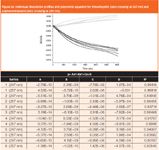
Figure 2a
Other formulations were studied according to the procedures described above. The multicommutation assembly was directly connected to the different solutions placed into the commercially available multiple bath provided with the corresponding mechanical stirrers in each vessel. The number of dissolution vessels in the assembly was 10; however, it was not possible to simultaneously develop too many replicas with the tested formulations. The experimental limit to the number of replicas was established by the time interval that was required from one measurement to the next, i.e., the interval necessary for one solution to reach the flow cell. The required interval in the proposed assembly was 6 or 7 min.

Figure 2b
The tested couples of pharmaceuticals were amoxicillin and clavulanic acid (genéricos Española, Spain) with the aid of the first derivative at 247 and 259 nm (Table 2), respectively; captopril and hydrochlorothiazide (Ratiopharm España, Spain) at 250 and 273 nm in the first derivative (Table 3); and enalapril and hydrochlorothiazide (also from Ratiopharm) at 218 and 273 nm.
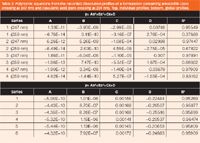
Table 2: Polynomic equations from the recorded dissolution profiles of a formulation containing amoxicillin (zero crossing at 247 nm) and clavulanic acid (zero crossing at 259 nm). Top, individual profiles; bottom, global profiles.
Conclusions
This study has demonstrated how dissolution profiles in pharmaceutical formulations containing two active principles with overlapping spectra can be simultaneously recorded using the standard proposed assembly provided with a diode array spectrophotometer. In previous papers, these three simultaneous profiles were obtained by means of flow injection analysis (FIA) or a multicommutation manifold. For this article, the idea was extended to simultaneously obtain different replicas from the same formulation.
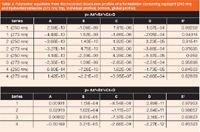
Table 3: Polynomic equations from the recorded dissolution profiles of a formulation containing captopril (250 nm) and hydrochlorothiazide (273 nm) Top, individual profiles; bottom, global profiles.
Our results show that the whole process can be performed by following a simple and cost-effective procedure based on a set of solenoid valves. The limiting factor to the number of possible profiles that can be assessed is the required time, which is connected to the dissolution speed of the individual profile. The online absorbance can also be corrected when the instrument output is saturated thanks to the flow manifold.
Further studies will work on increasing the number of simultaneously recorded profiles, bearing in mind higher flow rates and shorter distances from dissolution vessels to the spectrophotometer flow-cell. The time required to obtain the solution profile (sample solubility) is also a relevant parameter and must be further assessed so that we can increase the number of simultaneous processing replicas; low solubility means longer periods and a higher number of replicas.?
The author says…
- The authors describe a fast and automated method for obtaining replicas of dissolution profiles of a solid dosage form.
- Different continuous-flow multicommutation manifolds were designed and tested and were used to develop "individual" and "global" dissolution profiles of the same formulation.
- Results were developed by means of the derivative spectrophotometry and the zero crossing mathematical procedure.
- The study demonstrated how dissolution profiles in pharmaceutical formulations containing two active principles with overlapping spectra can be simultaneously recorded using the proposed assembly with a diode array spectrophotometer.
Ana Rita Pires is a PhD student at the University of Porto (Portugal).
D. López Malo is junior researcher at the Department of Analytical Chemistry, University of Valencia (Spain).
J. Martínez Calatayud is Professor of analytical chemistry at the Department of Analytical Chemistry, University of Valencia (Spain) jose.martinez@uv.es
References
1. United States Pharmacopoeia (USPXXIII), pp 1291, 1421 (1995).
2. British Pharmacopoeia, London 2010 edition on-line.
3. European Pharmacopoeia, 4th Edition (2002).
4. D. Mangin et al., Journal of Crystal Growth, 286(1), 121–125 (2006).
5. P. Bertocchi et al., J. Pharm. Biomed. Anal., 37(4), 679–685 (2005).
6. A. Moreno Galvez and J. Martínez Calatayud, J. Pharm. Biomed. Anal., 27, 1027–1036 (2002).
7. A. Moreno Galvez, J.V. Garcia Mateo and J. Martinez Calatayud, J. Pharm. Biomed. Anal., 30(3), 535–545 (2002).
8. M. C. F. Ferraro, P.M. Castellano and T.S. Kaufman, J. Pharm. Biomed. Anal., 30, 1121 (2002).
9. D. Tomšu, M. Catalá Icardo and J. Martínez Calatayud, J. Pharm. Biomed Anal., 36(3), 549–557 (2004).
10. E. Vranic, M. Catalá Icardo and J. Martínez Calatayud, J. Pharm. Biomed. Anal., 33(5), 1039–1048 (2003).
11. J.D da Rocha Pereira et al., Arabian J. Chem., 1(3), 1–4 (2008).
12. S.N. Deming and L.R. Parker Jr, CRC Crit. Rev. Anal. Chem., 7, 187 (1978).
13. D. López Malo and J. Martínez Calatayud, Talanta, 77(2) 561–565 (2008).
14. C.M.P.G. Amorim et al., J. Pharm. Biomed. Anal.,43(2), 421–427 (2007).
15. J. Martínez Calatayud, Flow Injection Analysis of Pharmaceuticals. Automation in the laboratory (Taylor and Francis, Cambridge, UK, 1996).
16. J.L. López Paz and J. Martínez Calatayud, Pharm. Technol. Eur., 10(3), 16–22 (1998).
17. P. Solich et al., J. Pharm. Biomed. Anal.,22(5), 781–789 (2000).
18. S. Görög, Ultraviolet-Visible Spectrophotometry in Pharmaceutical Analysis (CRC Press, Boca Ratón, FL, USA, 1995).
19. O.A. Odeku and O.A. Itiola, Pharm. Rev., 3, 147–153 (2005). www.pharmainfo.net
20. O.A. Odeku and J.T. Fell, J. Pharm. Pharmacol., 56(11), 1365–1370, (2004).
21. J. Berzas Nevado et al., Talanta, 46(5), 933–942 (1998).
22. G.A. Rivas, S. Laredo Ortiz and J. Martínez Calatayud, Anal. Lett., 29(12), 2115–2124 (1996).
23. J. Swanbrick and J.C. Boylai (Eds), Encyclopaedia of Pharmaceutical Technology, Third Edition (Marcel Dekker Inc., New York, USA, 1992) pp 121–167.
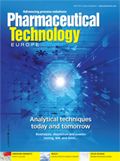
Drug Solutions Podcast: A Closer Look at mRNA in Oncology and Vaccines
April 30th 2024In this episode fo the Drug Solutions Podcast, etherna’s vice-president of Technology and Innovation, Stefaan De Koker, discusses the merits and challenges of using mRNA as the foundation for therapeutics in oncology as well as for vaccines.